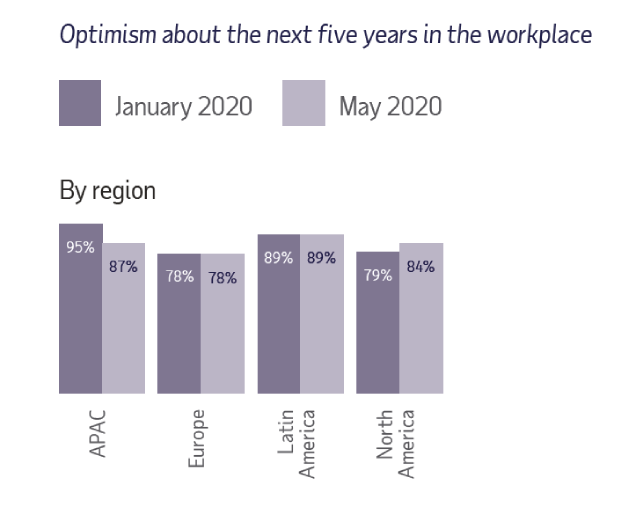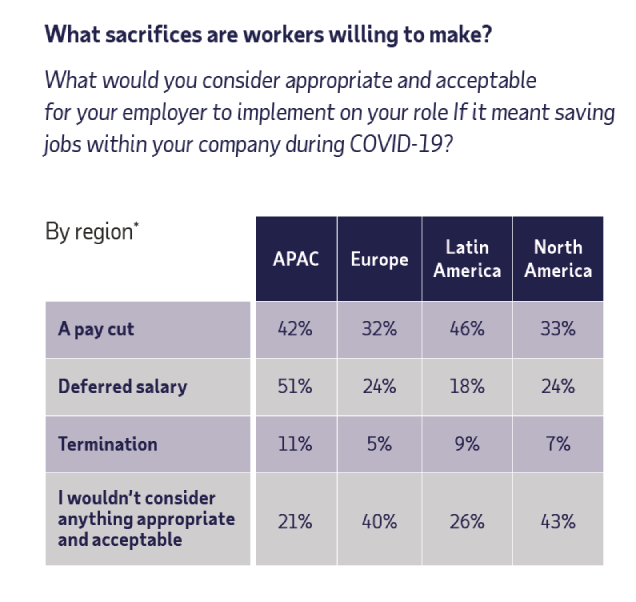
ADP study captures a timely snapshot of employee opinion before and after COVID-19 hits
The global outbreak of COVID-19 has challenged our old ways of working and urged us to reconsider workplace issues such as job security, flexible working and wellness.
How have employees’ feelings about work changed after the global pandemic?
Between late 2019 and early 2020, ADP Research Institute surveyed 32,442 workers in 17 countries across four continents, capturing a snapshot of employee opinion. In a quick-pivot response to COVID-19, a subsequent 11,000 workers were surveyed in six of the countries across the same regions, providing a robust picture of worker sentiment immediately before and after the virus took hold.
Positivity persists
Confidence has declined less than one might expect, with 84% of workers today still feeling optimistic about the next five years in the workplace (down from 86% pre-pandemic), and 75% feel buoyant about the year ahead. Optimism among young people is highest of all.
In APAC, optimism levels have fallen 8%, albeit from a much higher starting point, bringing the region more into line with the global average.

Flexible and remote working up
In the short-term at least, the pandemic has ushered in fresh impetus for flexible working, with mass moves to remote working disrupting traditional nine-to-five, workplace-based working practices.
Nearly half (44%) of employers now have official flexible working policies in place, up from 25% pre-COVID-19. Despite this progress, there may still be some way to go in enabling workers to feel empowered to take advantage of flexible working options, with only a quarter confident enough to do so.

Companies are sending mixed signals
While employers’ acceptance of flexible working appears to be on the rise, over half of employees (54%) felt pressured to come into work at some point during the pandemic, even when officials recommended non-essential workers stay at home. Despite HR and senior managers direct employees to stay home, 16% of employees report that individual managers determine whether one can work flexibly, regardless of official company policy.
Employees in APAC are especially feeling compelled to be physically present in the workplace, and in China, only 12% do not feel the pressure to come into work.

Unpaid work on the rise and pay cuts acceptable
Presenteeism has been pervasive in the workplace for some time and workers are giving employers even more ‘free’ time now given that the distinction between home and office is blurred.
The amount of unpaid overtime workers are doing has increased by an hour to seven hours per week on average since COVID-19 hit. Almost a fifth (19%) of employees globally and 28% in APAC say they now work 11 or more hours for no extra pay each week.

In an environment where many businesses have had to shut or downsize their operations, many employees recognise that hard choices need to be made due to the pandemic. Almost two in five (38%) of workers would be prepared to take a pay cut if necessary to save jobs due to COVID-19 but one in three (32%) are resistant to any moves to cut pay or defer salaries, even if it ultimately means saving jobs.

The outlook for employers and HR leaders
Although the immediate impact of COVID-19 has been significant, the long-term ramifications remain unclear. Things may never be quite the same again and while there are hurdles to overcome, there is potential for the world of work to evolve in a raft of positive ways.
Employers and HR professionals have to juggle multiple – and sometimes competing – imperatives. That might mean making tough calls around jobs and pay while maintaining employee moral and motivation; it may mean normalising flexible working on a more permanent basis, but in a fair way for everyone taking into account their different needs, as well as those of clients and customers; it could mean supporting workers in new ways, for example ensuring people feel part of virtual teams, that individuals can continue to develop their skills, or improving conditions for those working on the ‘front line’.
As suggested by another report of ADP Research Institute, employers who are taking steps to encourage remote collaboration and social interaction, communicating with positive messaging and focusing on safety are likely to be repaid in staff loyalty.
Challenges are undoubtedly ahead, so are the new opportunities. Are you prepared for the new world of work post-pandemic?
Download the full report of “Workforce View 2020” here to understand employees’ outlook and priorities at work, which will enable you to develop strategies that can navigate changes in the workplace, whatever the future holds.


